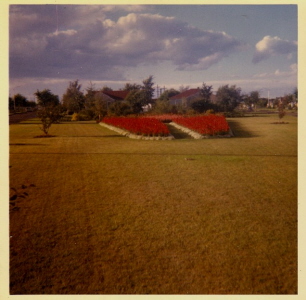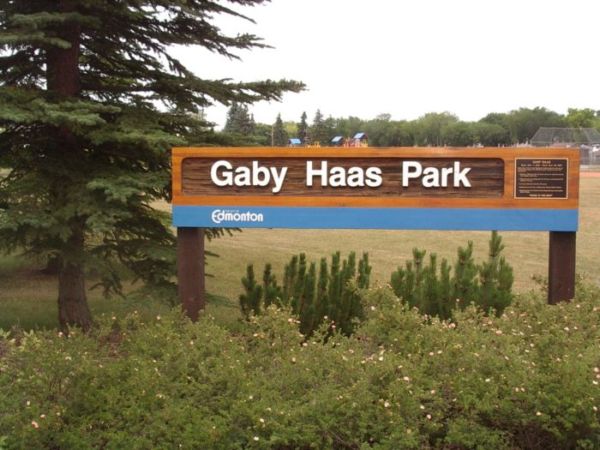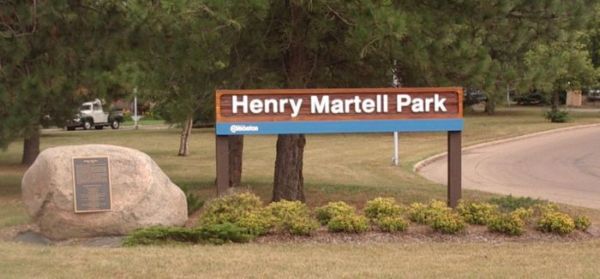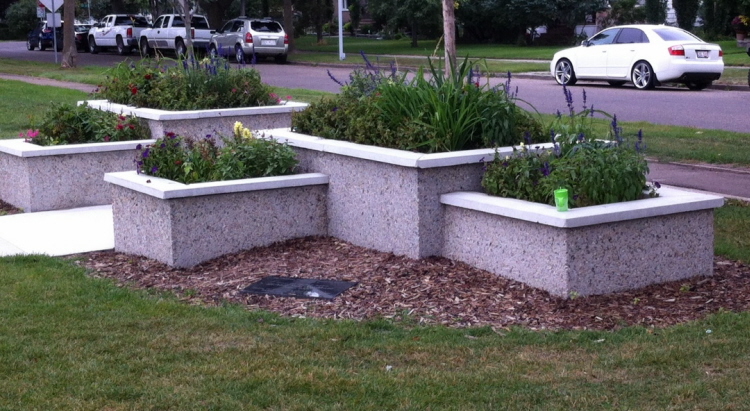|
OF THE HIGHLANDS-BELLEVUE COMMUNITY
|
|
|
|
INTRODUCTION My interest in the commemorative benches in the Highlands and Bellevue communities was aroused as I noticed them and then as I either wrote or encouraged other people to write, about the memorials they had had erected for departed loved one.
|
||||||||||||||||||||||||||||||||
|
I Enquiries were made via 311 how the border came about. October 30 still waiting. November 23, 2020 received the following information from Stacey [780-913-1418] Good morning my name is Stacey I am the supervisor for horticulture at the City of Edmonton. Sorry for not responding previously, I'm not sure how the request was missed. The east side in the area of 66 Street and 118 Avenue was redone as part of a life cycle neighbourhood project. I'm glad your happy with it. I'm not sure what else I could provide |
||||||||||||||||||||||||||||||||
|
||||||||||||||||||||||||||||||||
|
From Highlands-Bellevue Highlights, November 2010-January 2011 edition Big brown house returned to character of Edwardian gentility after years of work
Article by David Brooks from the Highlands Historical Society Newsletter Vol. 4 No. 2 Fall 1993 It is truly an experience to be able to talk with family members who can recount 80 years of living in the same house. The author sincerely thanks the Martells, senior and junior, the Craig family, and the Wheelers, for reminiscences. (Permission granted to use) Stroll north on 60 th/58 th Street from 112 th Avenue and you'll notice a house that seems to be out of place in a sea of post-Second World War residences. The home was built in 1912, but apparently sat vacant until Clyde and Minnie Smith bought it in 1918. A photo taken in the 1940's shows it to be not so much out of place, as pretty well out of town. To the north and east the photo shows a wall shows a wall of poplar and willow bush with no sign of neighbors. (The closest were at 61 st Street and 113 th Avenue.) There's a small barn hidden away in the back, and a large vegetable garden. The Smiths kept a cow named Buttercup and a flock of chickens. The "spread" eventually became known as Buttercup Farm . Clyde Smith held Edmonton's #1 auctioneer's licence for many years. Francis, one of the Smith's daughters, still lives close by, at 11227 -61 St. (The other children were Doris, Olive and Walter nicknamed Benny) Francis' son, Clyde Martell, lives with wife Maureen and son Scott at 11136 -61 St. Francis left the area in 1939 when she married policeman Henry Martell. But they moved back in 1942 into a suite in the Magrath Mansion coach house on 111 th Avenue while they built their new home at 11227 -61 Street. Officer Martell later became the first full-time golf pro at the Highlands course. Francis says that her grandparents, Gillan and Mary Armstrong also arrived in the Highlands in 1918 and resided at 11216 -60 Street, the present home of Jack Thomas and family. When Clyde and Minnie Smith moved out of the big brown house at 11243 -58 Street in 1942, the Craig family - Herb and Bessie, with daughters Jean, Phyllis and Carol - moved right in. The girls attended nearby Highlands and Eastwood schools. Phyllis still lives in Edmonton, Carol resides in St. Albert, and Jean lives in Grenada, in the West Indies. Bessie Craig lives in a high-rise on Saskatchewan Drive, with a distant view of her former neighborhood. The Wheeler family bought the house in 1962. Gordon Wheeler was 13 years old at the time. He later acquired the family home, and lives there with wife Vicki and daughters Chelsea and Brianne. Over the past few years the Wheelers have been up to their necks in renovations work, including all new plumbing and wiring. Gordon notes that one of the original fuses controlled just one outlet, while the adjacent one handled 24! Water in the early days came from an outside well. And a large cistern in the basement collected the rainwater from the downspouts, which was then hand-pumped to the kitchen sink. The Wheelers have done much scraping to remove layers of enamel paint from fine old fir casings and other woodwork. The house interior today would feel very much like the original "Buttercup Farm" of the Smiths: the dark stained fir window casings and ceiling beams in the dining room, the immaculate dark oak fireplace mantle and surround, and the precisely balanced sliding panel doors between dining and living rooms all maintain the original character of Edwardian gentility in the house. The buttressed brick foundation walls appear as sound as they were in the summer of 1912, and if you proceed through the door in the south wall you'll find yourself in a short stairwell right inside the attached garage with the family van hovering just above your head! The present exterior of the house is very little changed when compared with early photos. The old shed-roofed garage is gone, replaced by one in keeping with the character and detailing of the original house. The big brown house has been home to just three families in its 81 years, but the methods of escape employed by the children are similar. On warm summer nights, Gordon Wheeler sometimes went out through the back bedroom balcony and down the clothesline pole for an evening of freedom. The Craig girls left via the south bedroom windows, climbed onto the old shed-garage roof and then made a short jump to the ground - and a night on the town.  The form asked for a possible location for the sign, Vicki and the author agreed on the location, and also submitted suggestions for the type of plants. There was no response from the city for several weeks. Enquiries found the secretary had been sick for an extended period of time; however, she was being held up because th  Permission was given, the name approved, and it would be erected the next year. The author checked with the maintenance people who were to put up the sign and they were aware of it. OK, we have the name approved and the budget for the sign and the crew was aware of the sign needing to be put up. Permission was given, the name approved, and it would be erected the next year. The author checked with the maintenance people who were to put up the sign and they were aware of it. OK, we have the name approved and the budget for the sign and the crew was aware of the sign needing to be put up.
Years ago most flower beds in city parks were filled with bedding plants. It's not known when the flowers became the victims of budget cuts. Here in these photos of 1962 you will see a fine array of flowers. The pictures were provided by Vicki Wheeler, widow of Gordon. The young ladies in one of the the photographs are, on the left Vicki Wheeler, nee Wendt and her It's late spring and the author sees a crew putting up the sign, he tells them that the location is wrong. The sign was to be placed in the 'pointy' south end of the park, not hidden in the 'tree-overhung border' at the north-end. The placement of the sign meant it would be almost hidden from view and only offered a view to traffic southbound on 60 street. The supervisor of the crew indicated he would have to put the sign where he was putting it; several phone calls and a couple of days going by, resulted in the sign being removed and placed where originally requested. It was learned there was no communication between the Naming Committee and the people responsible for setting up the sign. The parks people had not notified nearby residents of the placing of the sign and they had received a concern from someone saying the sign was too high and blocked their view of the park. The height of the sign was reduced by a couple of feet or so. In the meantime the author had been asked to submit (again) a list of plants that would provide summer long bloom. With the help of a local nursery (Kuhlmanns) this was done. The plantings were done but bore no resemblance to the suggested plants. Vicki and her family were told there could be a ceremony to officially name the park. Arrangements were made,but the city got their dates mixed-up. Yes, this is a true account! So help me!
For someone with a minute or two to spare the file available you you is good for a read and a bit of a giggle... you would not believe how difficult it is to get (some)things done... to become tangled in red tape click here In July 20202 a notice was received by those living near Buttercup Park that the following changes would be made: A new concrete pathway that will include a coloured concrete feature in the shape of a buttercup. The installation of new benches, trash cans, landscape boulders and planting beds. August 2020: Picture on left was taken in mid August 2020 and shows a sidwalk installed along part of the west side of the park. The picture to the right shows the chain link fence being erected in late September
|
||||||||||||||||||||||||||||||||

By N. Breuer and J. Rollans (original source not known)
On Sunday, September 21, 1986, at 8.00 p.m. - for the 2081 st time - this same voice welcomed listeners to the same program. That marked the beginning of Gaby's 41 st year of broadcasting his program to Albertans, sharing with them a wide variety of recordings both old and new. Gaby emigrated to Canada from Czechoslovakia in July 1939, and his radio career began that same year. For quite a while, he played in bands, often juggling gigs with radio shows. He recalls those early days with a smile: "We were playing on five radio stations at a time, making anywhere from $3 to $5 a show - a lot of money in those days. At that time, a full-course meal, including pie and coffee, was only 35 cents." Gaby actually began his CKUA career in 1940, when the station was located on the U of A campus. He had about 50 records he had brought over from Europe. The music he plays is still his own, but the collection has expanded to include about 35,000 selections that he stores at home. In 1945 Gaby played on "Alberta Ranch House", a program that was carried by the CBC Trans-Canada Gaby Haas is well known throughout Canada and the United States as Canada's "Mr. Polka". He has released 57 record albums and is looking forward to "50 years on Radio, 40 years on records, and 35 years on TV," All this will happen in 1989 and then, having achieved nice, round figures", I'll retire." With some of his albums being re-released, Gaby's music will be heard for many years to come. The future? All the pertinent data on "Continental Musicale" has been forwarded to the editors of the "Guinness World Book of Records" in England. The New Zealand supplement to that publication lists a radio program in Wellington that was launched July 2, 1937, and ended on July 4, 1977 - but Gaby has topped that one. On that September Sunday in 1986, Gaby has established a new record: the longest-running radio program in the world - same air time, same day of broadcast, same host and producer.
(Perhaps a Q.C.F.M news release, undated.)
To satisfy the cultural and linguistic desires of the ethnic people Q.C.F.M. has hired the services of Mr. Haas is a Canadian recording artist with the distinction of having produced the largest number of records by any Canadian artist; to date he has recorded 51 albums. Besides being an accomplished musician, Gaby has a rare and comprehensive record collection containing over 100,00 "ethnic" records. For 15 years, he has produced a weekly radio program called Polka Party. This program can be heard on several Canadian radio stations. Before that time, he produced a program called Memories of Europe, where he played music from all the European countries. For Q.C.F.M. Gaby produces The World Showcase of Music, a mixture of music from all corners of the world. On a weekly basis he receives newspapers and letters from most of the European countries, subscribes to European music magazines., as well as most Canadian music publications. In addition to being an expert on music around the world, Gaby speaks eight languages fluently, and reads several more. Since starting his program Gaby has also generated interest from the Ethnic communities to produce their own programs. So far Gaby features a Pakistani Program, an Arabian Program. A German Features, A Scandinavian Show, and is presently negotiating a Chinese Show. Daily, Gaby does on hour request show, taking calls from listeners and playing their favourite music from "home", occasionally inserting some good old Canadian recordings. |
||||||||||||||||||||||||||||||||
|
HIGHLAND PARK (.6 ha)- approved February 8, 1984 Highlands Park: Initial investigation seems to indicate that the park was there and needed a name; it was in the Highlands so that was thought to be a suitable name! The secretary of the Park Naming Committee of the city could initially only tell me the park 'appeared' February 8, 1984! But more about that later. Several people in the area have been asked if they know when the park was first on the scene. Clyde Martell remembers playing football on the park in the fifties; the author remembers the park being there when he moved into Highlands proper in 1963. The secretary of the Parks Naming Committee was able to say that (remember the park is made up of 8 city lots): It is interesting to note the city assessment maps still shows the lot designations as noted above. So far we cannot tell how the city procured the lots. Metro Chrapko thought may be the lots had been donated: Perhaps it was in conjunction with the construction of the Community Hall in 1948, or the depression, or? The City acquired the land for those lots between 1923 and 1947. Three titled lots were acquired in the 1920's and one in 1947. There are actually four separate titles over five lots but all were purchased by the City between the years indicated. At least for the titled lots purchased in the 1920's, the price paid for the land was between $400 and $450. They remain as separate lots because the City has not yet moved to consolidate the property. In trying to discover more information about the naming of the park the author casually mentioned it at a meeting of the Highland Place Seniors' Home committee. From a 'confidential but reliable source'... in 1984 there was a move to have the park named after an ethnic dance group... this encouraged (?) people to have the park called Highlands... and the mystery deepens!! The 'great discovery' was shared with Cory Sousa, Planner, City of Edmonton, she provided the following... (Darrell Nordell, our own community coordinator has also been very much involved). Hi John, (informal because we 'chatted' back and forth... considerably!) I looked at the original minutes but there wasn't much detail. However, I do know that a particular dance group was looking at potential sites/parks to have named in their honour in and around the Highlands Neighbourhood in the past. While it's possible that this pushed the community to name their park 'Highlands', it wouldn't have been anything against any group, individual, or association. It's actually Parks Branch practice and stated in our Naming Policy to name the major park in a community after the Neighbourhood name. Therefore, one can assume that the community league pursued the naming of that park site to 'Highlands Parks' to have at least one park in their community reflecting their name and location, hence honouring the 'Highlands' heritage, regardless of who made an earlier application to name the park. There is also some context that needs to be recognized during the early 1980's. The City of Edmonton went through a major Neighbourhood and Community boundary clean-up during this time. During annexation in 1982, there was a greater realization that many civic departments, community leagues, and agencies used different boundaries to identify communities. It was then directed by City Council to clean-up these issues and establish very defined boundaries for the neighbourhoods in which ALL Civic Departments, Community Leagues, and Agencies (ie. EdTel, Edmonton Power, etc.) would use. This process eliminated smaller communities and their associated names. For example, what used to be known as two separate neighbourhoods 'Santa Rosa' and 'Montrose', were combined to form 'Montrose.' Many long term residents of 'Santa Rosa' were upset about this, but as a compromise, the park that resided in their area was officially called 'Santa Rosa Park' to reinforce the previous history of the 'Santa Rosa' community/subdivision. This process had to be done as there were many tiny subdivisions with their own unique names but the Administration needed consistency as Edmonton continued to grow. Therefore, one can assume that the residents of 'Highlands' (going through this neighbourhood clean up process too, as all communities did in the early 80's) also didn't want to lose their identity and acted quickly to name a park after their neighbourhood. No offence to any ethic dance group, individual, etc. but it was something the community most likely would have done eventually. I hope this all makes sense and helps solve the mystery to some degree. The tree make-up is similar to that of the other parks with poplars and firs in the majority. The park has a modern set of children's playthings, a wading pool, and facilities for the summer programs that are sponsored by the community and run by the city. The year 2012 saw some major, positive changes to the park. A series of picture follow, no attempt has been made to be artistic, merely to update the park! Enjoy
|
||||||||||||||||||||||||||||||||
 Henry Martell Park: The plaque shown below says it all... as it happens, and not Nicely situated between 65 and 66 streets bordering the north edge of Ada
Although small as previously noted the park contains a goodly number of mature trees. Community Services say it is likely there are poplar, Colorado spruce and may days. A quick check by the author revealed 38 trees. September 2015: Tidridge received an e-mail from Kim Lawrence, Visitor Services, Alberta Sports Hall of Fame& Museum requesting the date of death of Henry Martell. [she had taken the time to open this site.] It had come to light in her research there were several dates quoted at different sources. What to do? A name immediately came to mind... Ted Smith. The answer came from Ted the same day, he contacted Maureen Martell Henry's daughter in law and the date was discovered to be June 12, 1984. I think Howard Lawrence would be pleased to read of this as it came about because some people take the time to nod, stop and chat... and share. Thank you Ted and especially Maureen.
|
||||||||||||||||||||||||||||||||
 n 2020 much road work, boulevard repairs and enhancement took place in the Highlands. In October it was noted a wide border of shrubs and firs had been planted on the east side of 66 Street just south of 118 Avenue. Looks very good.
n 2020 much road work, boulevard repairs and enhancement took place in the Highlands. In October it was noted a wide border of shrubs and firs had been planted on the east side of 66 Street just south of 118 Avenue. Looks very good.


 e community league had not answered her request to verify the permission already given. It turned out the community league president's computer had suffered a melt down and he was unaware of the request.
e community league had not answered her request to verify the permission already given. It turned out the community league president's computer had suffered a melt down and he was unaware of the request. sister Donna Montgomery nee Wendt. Their parents, long time Highlands residents, lived across the avenue from the park on 113 Avenue and 60 Street. Mr. Wendt was principal at Eastglen Composite High School.
sister Donna Montgomery nee Wendt. Their parents, long time Highlands residents, lived across the avenue from the park on 113 Avenue and 60 Street. Mr. Wendt was principal at Eastglen Composite High School.




 On Sunday, September 15, 1946, at 8.00 p.m. a voice was heard on CKUA making an announcement that would become a standard opening phrase: "Good evening ladies and gentlemen, and welcome to Continental Musicale, an hour of European music and songs. I'm your host, Gaby Haas".
On Sunday, September 15, 1946, at 8.00 p.m. a voice was heard on CKUA making an announcement that would become a standard opening phrase: "Good evening ladies and gentlemen, and welcome to Continental Musicale, an hour of European music and songs. I'm your host, Gaby Haas". network from Vancouver to Montreal. He has fond memories of fellow performer Ameen (King) Ganam, who went on to start "Country Hoedown" on CBC. After King Ganam went east, Gaby became leader of the band, changing its name to the "The Barn Dance Gang." (Former CKUA sportscaster Art Ward played trombone with this band from 1945 to 1946.) Gaby recalls Harry Boone's contribution to the program with a mischievous smile. "He used to arrange our music. The man was very good, but the arrangements he wrote were tough. He knew that I couldn't read music very well = not enough to hurt my playing."
network from Vancouver to Montreal. He has fond memories of fellow performer Ameen (King) Ganam, who went on to start "Country Hoedown" on CBC. After King Ganam went east, Gaby became leader of the band, changing its name to the "The Barn Dance Gang." (Former CKUA sportscaster Art Ward played trombone with this band from 1945 to 1946.) Gaby recalls Harry Boone's contribution to the program with a mischievous smile. "He used to arrange our music. The man was very good, but the arrangements he wrote were tough. He knew that I couldn't read music very well = not enough to hurt my playing." Canada's Mr. Polka, Gaby Haas.
Canada's Mr. Polka, Gaby Haas.






 by coincidence, the Park is immediately north of the Highlands Golf Course and slightly east of the entrance. A fitting location! This park is small but honours a man large in the golf history of this city...
by coincidence, the Park is immediately north of the Highlands Golf Course and slightly east of the entrance. A fitting location! This park is small but honours a man large in the golf history of this city... Boulevard, the park contains the Singer bench... and therefore not only do you have the park you have place so sit to watch not only golfers coming and going but the 'regulars' who walk the boulevard. Included in this number would be Clyde and Maureen Martell, Clyde is Henry's son.
Boulevard, the park contains the Singer bench... and therefore not only do you have the park you have place so sit to watch not only golfers coming and going but the 'regulars' who walk the boulevard. Included in this number would be Clyde and Maureen Martell, Clyde is Henry's son.